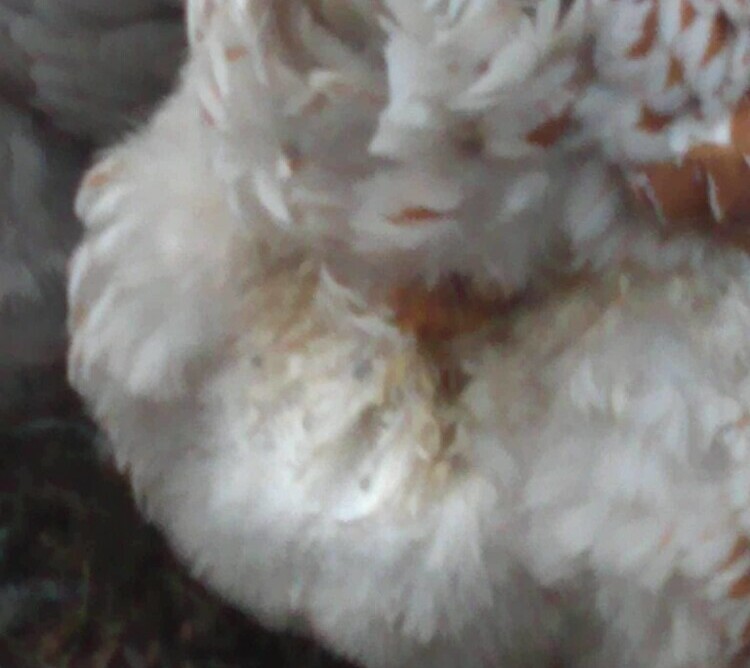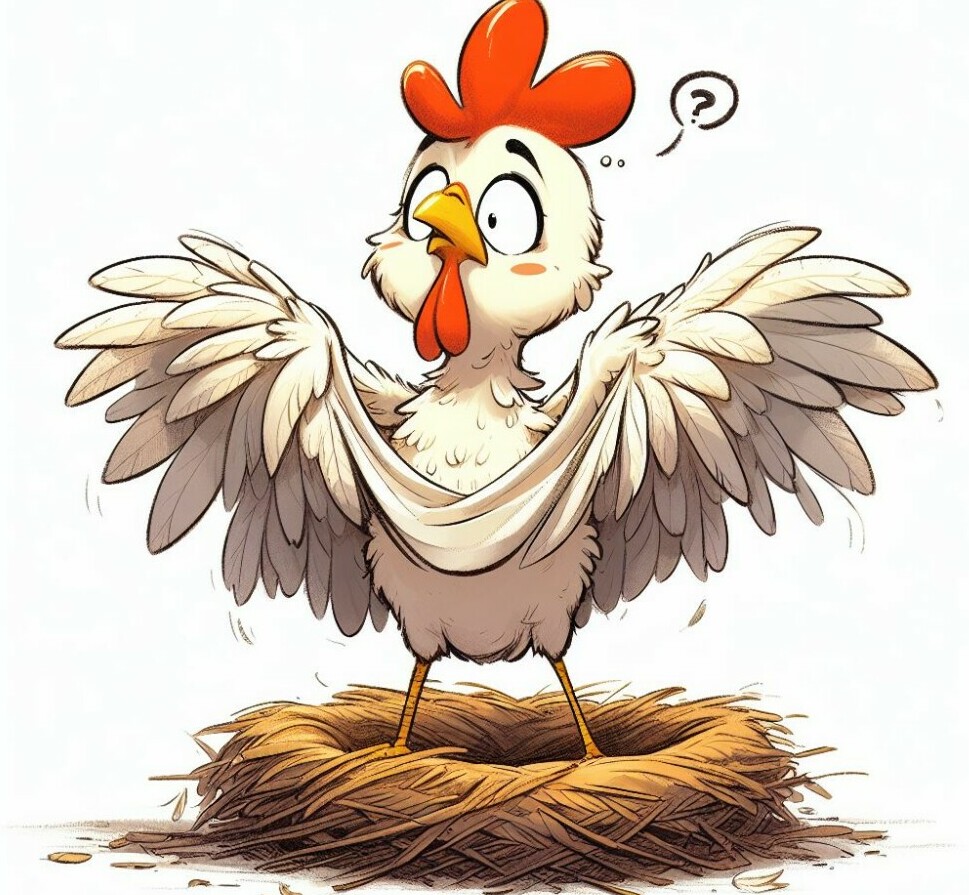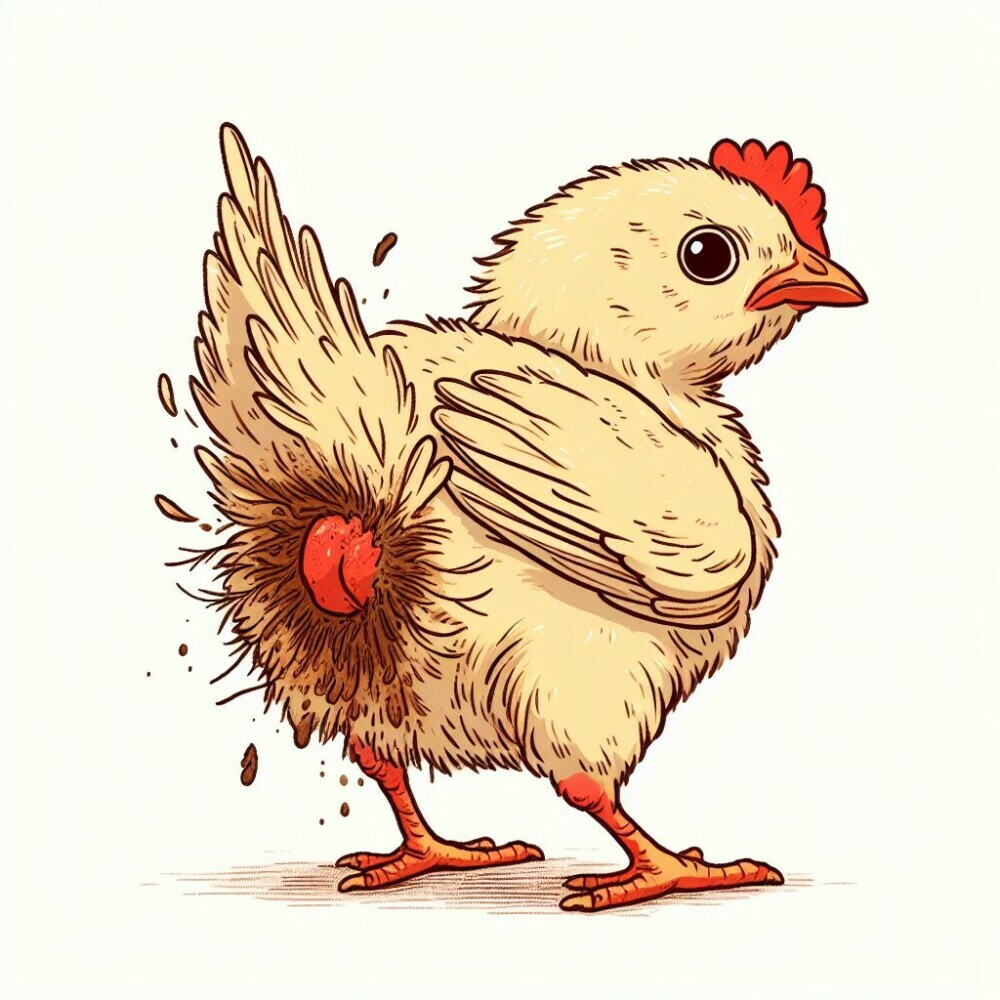What is Chicken Vent Gleet?

Chicken Vent Gleet is a potentially chronic chicken vent inflammation usually accompanied by an abnormal discharge. It is also called cloacitis because it occurs in the cloaca and subsequently the vent.
The cloaca is a common cavity at the end of the digestive tract for the release of both excretory and genital products.
Okay, so I have been very diplomatic up until now. So that you don’t have to use your imagination, the cloaca is a sewer basin where poo and stuff gather just before the vent.
You can figure out that there can be a lot of nastiness going on in the cloaca. Any disease, parasite, bacteria, etc., generated in the chicken prior to the cloaca ends up there.
Vent gleet can come from a number of sources. Knowledge is power, so finding out the origin of a particular problem is important for the health of your flock.
How Does Chicken Vent Gleet Start?
Let’s take a look at chicken vent gleet, focusing on how it starts, its common causes, and the factors that might increase the chances of this condition.
Vent gleet, or cloacitis, often begins as a bacterial or fungal infection in the digestive tract. This can occur due to an imbalance of the natural flora in the gut.
Chickens living in environments that are not kept clean or damp are at a higher risk. The buildup of feces and wet bedding creates a breeding ground for harmful bacteria and fungi.
Additionally, stress, such as that caused by overcrowding, can weaken a chicken’s immune system, making them more susceptible to infections like vent gleet.

Diet plays a significant role as well.
An imbalanced diet can disrupt gut health and contribute to the onset of vent gleet.
Also, chickens with pre-existing health issues, especially those affecting the digestive system, are more prone to developing this condition.
Inadequate nutrition, whether it be nutrient deficiencies or excesses, can disrupt the digestive system’s balance.
Unsanitary conditions in the coop increase the risk of infections. Constant exposure to wet conditions can irritate the cloacal area, while parasites like worms can trigger or exacerbate vent gleet.
Furthermore, while antibiotics are sometimes necessary, their overuse can lead to an imbalance in gut flora.
Several factors can increase the risk of vent gleet. Older chickens or certain breeds may be more susceptible.
Environmental stressors, such as extreme temperatures, either hot or cold, can stress chickens and weaken their immune systems.
Poor ventilation in the coop, leading to ammonia buildup from urine, can irritate the respiratory and digestive tracts.
Overcrowded conditions lead to stress and increased contact with feces, raising the risk of infection.
Finally, a lack of regular health checks can mean missing early signs of health issues worsening untreated conditions into vent gleet.
Identifying the Dangers of Chicken Vent Gleet
Now that we know where it comes from, we’ll look into the dangers associated with chicken vent gleet, examining its potential issues, implications on the chicken’s overall health, and its effect on egg production.
Vent gleet in chickens is more than just a discomfort; it poses several serious risks. If left untreated, this condition can lead to many health issues.
The inflammation and infection associated with vent gleet can spread, affecting more systems than just the digestive tract.
This can lead to a weakened immune system, making the chicken more susceptible to other diseases and infections.
The discomfort and pain caused by vent gleet can also lead to changes in behavior, such as reduced feeding, which in turn can lead to nutritional deficiencies and weight loss.

Examination of Potential Issues Arising from Chicken Vent Gleet
The infection that causes vent gleet can have systemic effects.
As the condition progresses, it can result in severe inflammation, and in some cases, the infection may spread to other parts of the body, including the reproductive system.
This can lead to further complications, including secondary infections that are often more severe and harder to treat.
Moreover, the presence of vent gleet in a flock can also pose a risk of spreading the infection to other birds, especially in conditions where hygiene is compromised.
What Chicken Vent Gleet Means to the Overall Health of the Chicken
The overall health of a chicken with vent gleet is significantly compromised.
The condition can cause severe discomfort, leading to stress, a well-known factor in lowering immunity. This weakened state leaves the bird vulnerable to other illnesses.
In severe cases, if left untreated, vent gleet can be life-threatening. It’s crucial to address the condition promptly to prevent it from escalating into a more serious health issue.
How Cloacitis Affects Egg Production
Vent gleet can have a notable impact on egg production.
The stress and discomfort caused by the condition often lead to decreased laying frequency. In addition, since vent gleet can involve the reproductive organs, it may directly affect the health and functionality of these organs, further impacting egg production.

In some cases, the quality of the eggs can also be affected, leading to eggs that are less viable or with altered shell quality. This reduction in the quantity and quality of eggs can be a significant issue for those of you who rely on your flocks for egg production.
Recognizing the Symptoms of Chicken Vent Gleet
We now know what it is, where it comes from, and how it affects a flock. Now, we will discover the common visible symptoms of chicken vent gleet and additional signs that may indicate the presence of this disease.
Common Visible Symptoms of Chicken Vent Gleet

The visible symptoms of vent gleet are quite distinctive and can be easily spotted if you know what to look for.
One of the most obvious signs is a red, swollen, and inflamed vent area. You might also notice a foul-smelling discharge, which is often white and creamy in texture. This discharge can mat the feathers around the vent, leading to a dirty and unkempt appearance.
The chicken may also show signs of discomfort, such as pecking or scratching at the vent area.
In addition to these physical symptoms, there can be behavioral changes.
Chickens with vent gleet may appear lethargic or less active than usual. They might spend more time sitting and show less interest in their surroundings, including a reduced appetite.
Since the condition is painful, they may also be less tolerant of being handled.
More Signs to Watch for That May Indicate Cloacitis
Beyond the most obvious symptoms, there are other signs that can indicate the presence of vent gleet.
One key sign is a change in the consistency or appearance of the chicken’s droppings. The droppings may become watery, more frequent, or contain undigested food.
Another indication is decreased egg production, as vent gleet can affect the reproductive system.
In more advanced stages of the disease, you might observe signs of general ill health, such as weight loss or a pale comb and wattles, indicating anemia or systemic infection.
The chicken may also isolate itself from the rest of the flock, a common behavior in sick birds.
Monitoring for these symptoms is crucial in identifying and treating vent gleet early.
Early intervention can prevent the progression of the disease and reduce the impact on the chicken’s health and well-being.
Being observant of these signs can help ensure prompt and effective care for your flock. Speaking of caring for your flock.
Here is the moment we’ve all been waiting for…
DRUM ROLL PLEASE!
Let’s discuss the effective treatment of chicken vent gleet, including the steps to take when first noticing signs of the disease and preventative measures that can help avoid it.
Treating Chicken Vent Gleet Effectively
When it comes to treating vent gleet, the approach is multifaceted.
The first step is often to isolate the affected chicken to prevent the spread of infection and to make treatment more manageable. Isolation also keeps other chickens from pecking at the seemingly wounded bird.
Cleaning the vent area gently but thoroughly is crucial. This can be done using a mild, warm, saline solution and followed up with an antiseptic solution such as betadine.
In cases where a fungal infection is present, antifungal medications may be necessary. If the condition is bacterial in nature, a veterinarian may prescribe antibiotics.

Following the vet’s instructions carefully regarding medication dosage and duration is important. If the condition seems severe, a sample of the droppings should be examined to find the offending cause of the disease.
Dietary adjustments also play a significant role in treatment.
Providing a well-balanced diet can help improve gut health. Probiotics, either in the form of supplements or naturally occurring in foods like yogurt, can help restore the natural gut flora.
Ensuring the chicken has access to clean, fresh water at all times is also vital.
Steps to Take When the First Signs of the Disease are Noted
Early intervention is key in effectively managing vent gleet.
At the first signs of the disease, such as a dirty vent or changes in droppings, isolate the chicken to monitor its symptoms and prevent the spread of the condition.
Clean the affected area and observe the bird’s behavior and appetite closely. If symptoms persist or worsen, consult a veterinarian for a precise diagnosis and treatment plan.
Preventative Measures That Can Help Avoid the Disease
Preventing vent gleet is largely about maintaining good flock management and hygiene practices. Regularly clean and disinfect the coop to minimize the risk of infections.
Ensure the coop is well-ventilated and not overcrowded. Provide a balanced diet and clean water, and consider adding probiotics to support gut health.
Regular health checks are crucial to catch any issues early, and managing stressors like extreme temperatures or aggressive flock mates can help keep your chickens healthy.
You Are Now a Chicken Vent Gleet Expert
In conclusion, effectively treating and preventing chicken vent gleet involves a combination of good hygiene, proper diet, timely medical intervention, and attentive care.
By understanding the symptoms, treatment methods, and preventive strategies, you can ensure the health and well-being of your flock.
Keeping these practices in mind will address vent gleet and contribute to the overall health of your chickens, supporting a happy and productive chicken-keeping experience.
If you have any experiences with this problem, please tell us about it in the comments below. Thanks a bunch.
Dave
Chickenmethod.com

This article is wonderful and full of great advice. Who ever knew such delicate situations can happen. This also can happen so quickly, so as you have mentioned – attentive care to your flock is a MUST!
Thank you for educational counseling. I truly value it.
Thanks for the kind words, Donna. Most chickens only live a few years, so they get everything done quickly:) Seriously though, a chicken can seem perfectly fine one day and the next you can find them lifeless on the coop floor. I am always happy to answer your questions, Donna. I love what I do!
Dave
I have a question. Our rooster seems to develop a red vent and scratching/biting at his vent feather when he gets the same higher protein from feed.
Suggestions?
Hi, Cindy!
Oh no is our first response, right? The thing is, there’s always a cause of a situation so let’s dig in.
First, it sounds like your rooster might be reacting to the higher protein content in his feed, which can sometimes cause irritation or discomfort in some birds.
There are other possibilities.
Check for Parasites. The redness and irritation around the vent could indicate the presence of external parasites like mites or lice. These pests can become more active when a bird’s diet changes, especially if it impacts their immune response. Inspect the vent area closely, and if you find any signs of parasites, consider treating him with an appropriate poultry-safe parasite treatment.
Adjust Protein Levels. While protein is essential for a healthy diet, too much can cause issues, particularly if your rooster isn’t as active or if his body doesn’t need that extra protein. Try gradually reducing the protein content in his feed to see if his symptoms improve. You can mix his regular feed with a lower-protein option or provide more grains and vegetables to balance his diet.
Supplement with Probiotics. Higher protein levels can sometimes disrupt the balance of good bacteria in a chicken’s digestive system, leading to discomfort or irritation. Adding a probiotic supplement to his diet might help restore balance and reduce irritation.
Provide Dust Baths. Ensure your rooster has access to a good dust bath. Dust baths help chickens keep their feathers and skin healthy by reducing irritation and preventing parasites from taking hold. In fact, if you can catch him and give him a good dusting with diatomaceous earth, keeping it away from his nostrils, that would be a great way to get rid of any critters on him immediately.
I hope one of these options helps, Cindy.
Have a great day.
Dave